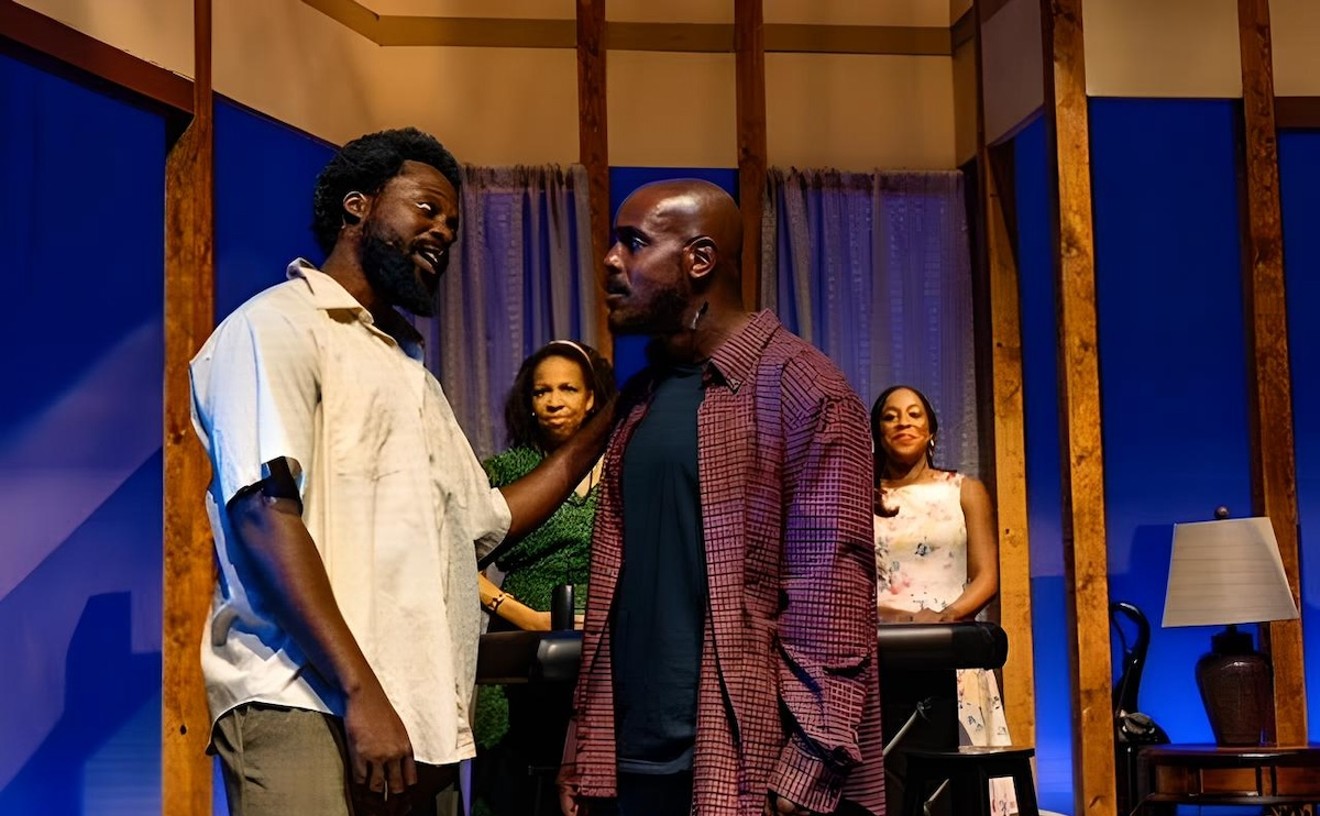Behar, who teaches at the University of Miami's School of Architecture, and artist Rosario Marquardt, his wife and collaborator, are standing high up in the eight-story Riverwalk Metromover station late on a recent afternoon. Leaning precariously over the waist-high security wall at the top the emergency stairs, they peer below into the deep crevice between the two slanted peaks of a 45-foot-tall and 20-foot-wide reinforced-concrete M that sits at the bottom of the station, a project they designed for Metro-Dade Art in Public Places. It was recently completed after what the couple calls a two-and-a-half-year-long "odyssey."
The Riverwalk station, where the Metromover crosses the Miami River and enters the line's Brickell extension, occupies ground zero of Miami's urban sprawl. The NationsBank Tower (the former CenTrust building) thrusts up like a missile to one side. Rusty barges crawl slowly down the river on another. Nearby, expressway ramps curve over endless parking lots. An assortment of gray drab towers more suited to a northern city rise up here and there, while down below colorful merchandise spills onto the sidewalk from a row of shops with multilingual signs, creating an impromptu bazaar. At night the scene becomes even more surreal, when the NationsBank Tower bathes everything around it in an iridescent Blade Runneresque glow.
Inspired by this hyperactive crossroads of clashing cultures, Behar and Marquardt A who moved to Miami from Buenos Aires in 1983 A designed the M, as they wrote in their proposal for the project, "in the tradition of Diego Rivera, Andy Warhol, Haitian painting, and the best of modern times." It incorporates both the large-scale graphic sensibility of American signage and the dreamlike proportions and colors of Latin American magic-realist painting. Covered with smooth stucco and painted with a lime-based natural pigment, the work is not fire-engine red, but rather the color of a Caribbean sunset. It stands on an expanse of pale yellow concrete that gives the impression of sand in the midst of downtown's asphalt desert. The structure acts as a gateway to the city for passengers exiting the station's turnstiles, and the space between the legs of the letter creates a human-size doorway at the top of which hangs a stainless-steel clock with arrows for hands.
"In Miami, a city of immigrants, it's very important to create common images," asserts Marquardt. "We may not have common memories, but the M is meant to create a memory that we can all share."
Metro-Dade Art in Public Places executive director Vivian Donnell Rodriguez, who was on vacation last week, notes in a press release that she hopes the new piece will become a Miami landmark, something akin to the huge clock in New York City's Grand Central Station. The M's clock will be set in motion next week, when the sculpture is officially inaugurated at an invitation-only party to be attended by county and city officials. But it has already established itself as a monument of sorts, with tourists posing for pictures in front of it.
Even before construction on the project started this past January, the M was being lauded as a symbol of Miami in national design publications such as the New York-based Metropolis magazine. Additionally, Between Two Towers, a new book by architect Vincent Scully, includes one of Behar and Marquardt's vibrant renderings of their project. "The M will surely become a decisive presence among the rather straggly towers that have come to shape Miami's skyline," Scully comments in his book.
But not everyone immediately recognized the M as an important contribution to urban design. Members of the Miami City Commission, who had to approve the sculpture before construction began, considered it something of a red menace when the artists presented the project to them last July, with Commissioner J.L. Plummer going so far as to say that it looked like "a giant clothespin."
Before getting a go-ahead from the commission, Behar and Marquardt had to run their design past members of the board of Art in Public Places, the Metro-Dade agency funded through a percentage of county buildings' construction costs. (By law, Art in Public Places receives 1.5 percent of each building's construction costs, which it applies toward placing artwork in that particular building; the M project cost $85,000.) In the fall of 1993, Rodriguez asked the couple to submit a proposal for the Riverwalk station. Unlike other artists, who have designed pieces to go on the walls, floors, or ceilings of other Metromover stations, the pair wanted to create an autonomous work outside the station's entrance.
"The idea was to bring life to the station," explains Behar. "If you just put a work inside the station, it's a more decorative piece. There's a difference between decorating an area and giving meaning to a space."
First the architect/artist team proposed building a "little skyscraper," a black tower with a revolving globe on top, a monument that made reference to the multicultural character of Miami. However, the Art in Public Places panel rejected that idea on the grounds that the work was "too intellectual and didactic." They also didn't want a monument that was black.
Behar and Marquardt went back to the drawing board and came up with the M, a simpler image in a brighter color, and the panel signed off on it. Next, because the piece was to be placed on city property outside the confines of the station, the project had to be sanctioned by the city commission. After Art in Public Places's Rodriguez showed the commissioners a drawing of the work at the July meeting, she was met with some skepticism.
Commissioner Plummer and others expressed concern that construction on the "giant clothespin" would disrupt business at Bijan's on the River, a restaurant located next to the station on SE 4th Street. "M stands for miserable," Plummer quipped at the time, according to a report that appeared in the Miami










